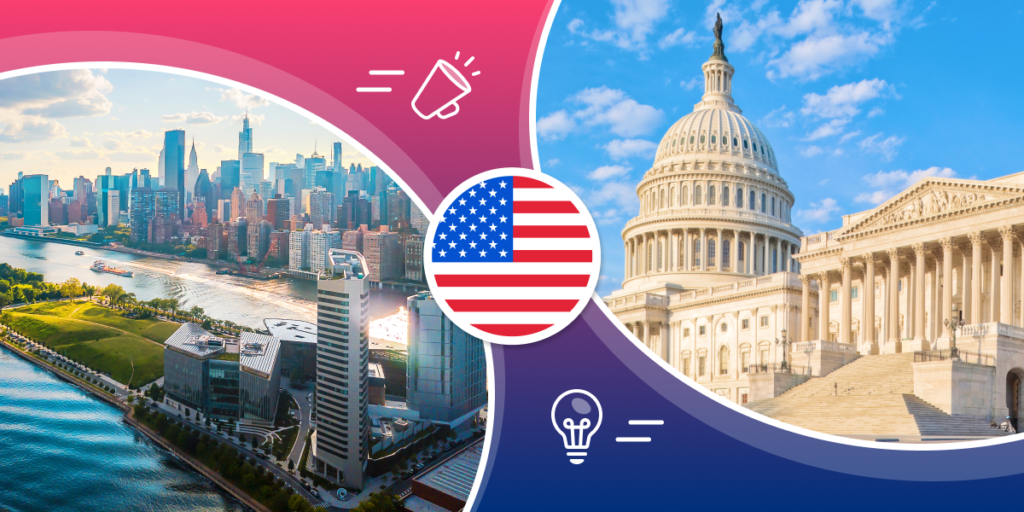Becoming an international student can be a journey that’s full of surprises. You’ll learn a lot about yourself and the place you’re studying in. We’ve collected a list of six surprising things about being an international student in the United States, from what you might call your professor to strategies for adapting to a multicultural environment. Curious? Keep reading to learn more.
Are you planning to study in the US? We met with representatives from DePaul University and Washington State University to get their top tips for international students.
So Many Choices
It may take some time to adjust to ordering food in the US, whether you’re deciding how you’d like your burger or crafting your perfect Starbucks coffee order. You’ll find there are often many choices to make, instead of simply ordering off of a set menu.
Some restaurants even have a “secret menu” where you can order off-menu dishes, as long as you know what to ask for. Many restaurants can also adapt to customer wants and needs, whether you have dietary restrictions, or are following a cultural or religious diet.
From making a shopping list to eating in-season, these strategies to eat healthy on a student budget can help you stay on track.

So Many Voices
The US is one of the world’s most diverse countries. This is due both to its history and position as an economic superpower. While diversity brings dreamers and innovators together to drive many fields forward, the road to progress often comes with its own challenges.
So, understanding a little about how race, culture, and class have influenced American history (and its current events) can be helpful. As this Daily Princetonian article notes, researching in advance, or learning about race in your international student orientation, can help you understand things like which words never to use—even at karaoke, or how to empathize with folks of different identities.
If you search for “books or movies to understand American culture” on Google, you’ll get over 450 million results. That’s more than anyone could take in! And maybe that’s the real answer—there’s not one “best” way to explain how the US works. So, be open-minded: check out media from different decades, authors, and points of origin. By learning about the US from many perspectives, you’ll be able to adapt faster.

“American English” Isn’t The Same Everywhere
Did you know that in the US, it’s believed folks speak over 24 dialects of English? This means that the English you’ll hear in San Diego, California, sounds different from how folks speak in Boston, Massachusetts. A slow Southern drawl in Georgia is very different from the quick, French-influenced Cajun English many folks speak in Louisiana.
As an international student, it can be frustrating to adapt to a local version of English. This is especially true if you’ve learned Standard English or Received Pronunciation. Be patient with yourself as you adjust. Your ear will adapt, and you might pick up some unique slang!
Want to get an early start? Try watching movies or TV shows set in the state you’re studying in. You can also listen to podcasts or follow social media creators who live in your new city or state.
Before you arrive in the US, boost your Gen Z slang knowledge with our short video:

Indoors Culture
Some international students will notice there are fewer people walking around or visiting on front porches, compared to what they might be used to. Some of this is because of the weather. Long and cold winters means spending more time inside!
This is also because many North American cities are built to encourage travel by car. In other parts of the world, it’s easier to travel by foot, bicycle, or public transit, which leads to a more lively streetscape.
Quiet streets are peaceful, but they can feel lonely. So, if you want to connect with other students, join a student club on campus. Many American universities and colleges have dozens of clubs, with something for everyone! You can also pick up a local paper or visit a library to learn about cultural groups and events in your city or town. Whether it’s a carnival, a football game, or a potluck dinner, local events bring communities together.
Being a new international student can be stressful. Here are some of our top stress-busting resources and ideas.

Love of the Open Road
Because it’s easy to drive around the US, traveling longer distances by road can be much faster than in many other parts of the world. While you might not have a car, many students rent one for a weekend or a holiday to explore different parts of the US. You can drive along sandstone pillars in the Southwest and feel like you’re in a Western film, pick a coastal highway for seaside views, or explore the Great Smoky Mountains on the Blue Ridge Parkway. If you’re studying in a smaller community, road tripping to a larger city can create great memories, too.
There are few images as American as someone starting a journey on an open road. Want some inspiration? Road trip stories are almost as popular as road trips themselves.
Planning a trip? Travel safely. Let friends know where you’re going and when you plan to return. Know if your rental car contract or credit card includes roadside assistance. It’s also good to check in with a friend or family member during the trip, even to share a photo or two. That said, you might want to wait to post on social media until you’re back, especially if you live off-campus, to help prevent theft.

Friendly and Welcoming Folks
When making this list, one theme kept coming up: many international students are surprised by how friendly Americans are. While it’s true that negative stereotypes exist, the majority of people will help you out if you need directions in a new city. Some may even start a casual conversation when waiting in line.
American speech is often more informal, even with your instructors. How they want the class to address them will vary. Some will ask you to call them “Professor” or “Doctor” and their last name; others will ask you to just use their first name. That last option can surprise international students who are used to being more outwardly respectful.
In general, communication in the US is direct. So, students from countries where communication styles are indirect may have to be more clear to be understood. (In your home country, can “yes” mean “yes,” “no,” or “maybe” depending on the situation? If so, it’s likely you’re used to a more indirect communication style.)

These may be some of the surprises you’ll experience as an international student in the United States, but they won’t be the only ones! Whether you study in the US for one year or ten, you’ll find it’s a place that is always evolving.
Get matched with study programs at top US colleges and universities on the ApplyBoard platform.




